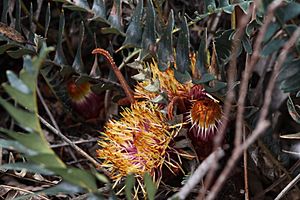Drummond's dryandra facts for kids
Quick facts for kids Drummond's dryandra |
|
|---|---|
 |
|
| Banksia drummondii subsp. drummondii | |
| Scientific classification | |
| Genus: |
Banksia
|
| Species: |
drummondii
|
| Synonyms | |
|
Dryandra drummondii Meisn. |
|
Banksia drummondii, often called Drummond's dryandra, is a special type of shrub. It grows only in Western Australia. This plant has unique leaves that are deeply cut, almost like feathers. It also produces beautiful flowers. These flowers are cream, red, and yellow. They grow in large groups, sometimes with up to one hundred flowers together. The plant's fruit is smooth and shaped like an egg.
Contents
What Drummond's Dryandra Looks Like
Banksia drummondii is a shrub that usually grows up to about 1.5 meters (5 feet) tall. It has straight stems. Its leaves are long, from 15 to 90 centimeters (6 to 35 inches) in length. They are also narrow, about 2.5 to 7.5 millimeters (0.1 to 0.3 inches) wide. Each leaf sits on a stalk called a petiole.
When the leaves first appear, they are covered with rusty-colored, soft hairs. Each side of the leaf has between 10 and 22 triangle-shaped or oblong sections. The top of the leaf is a pretty bluish-green color. You can easily see the veins on the underside of the leaves.
The flowers grow in groups of 60 to 100 at the ends of the branches. At the base of these flower groups are rusty-haired bracts. These are like small, leaf-like structures. Each flower has a pale yellow perianth, which is the outer part of the flower. This part is about 37 to 56 millimeters (1.5 to 2.2 inches) long. The flower also has a thick, cream-colored or red pistil. This is the part of the flower that receives pollen. It is about 43 to 69 millimeters (1.7 to 2.7 inches) long.
Drummond's dryandra usually flowers from May to June or from November to January. After flowering, it produces a smooth, egg-shaped fruit. This fruit is called a follicle and is about 16 to 20 millimeters (0.6 to 0.8 inches) long.
How it Got its Name
This plant was first officially described in 1848. A scientist named Carl Meissner gave it the name Dryandra drummondii. He published his description in a book called Plantae Preissianae. The plants he studied were collected near the Swan River Colony by James Drummond. The name drummondii was chosen to honor James Drummond, who found these first plants.
In 1996, another scientist, Alex George, described three different types, or subspecies, of this plant:
- Dryandra drummondii subsp. drummondii: This type has a yellow pistil (the part of the flower that receives pollen) that is 43 to 60 millimeters long. It flowers in the summer.
- Dryandra drummondii subsp. macrorufa: This type has a red pistil that is 60 to 69 millimeters long.
- Dryandra drummondii subsp. hiemalis: This type also has a yellow pistil, 43 to 60 millimeters long, but it flowers in the winter.
Later, in 2007, scientists Austin Mast and Kevin Thiele moved all Dryandra species into the Banksia group. So, Dryandra drummondii was renamed Banksia drummondii.
The new names for the subspecies are now:
- Banksia drummondii subsp. drummondii
- Banksia drummondii subsp. hiemalis
- Banksia drummondii subsp. macrorufa
Where it Grows
Each subspecies of Drummond's dryandra grows in slightly different areas:
- Subspecies drummondii is found in the Stirling Range. It also grows in areas like South Stirling, Kendenup, and Ongerup. It prefers mallee and kwongan habitats.
- Subspecies hiemalis grows in forests and woodlands. You can find it between New Norcia and Wickepin.
- Subspecies macrorufa is only known from near Nyabing. It grows in low kwongan areas there.
Future of the Plant
Scientists have studied how climate change might affect this plant. They found that the areas where it grows could shrink by 50% to 80% by the year 2080. This depends on how much the climate changes.
Protecting Drummond's Dryandra
The Western Australian Government's Department of Parks and Wildlife keeps track of plants that might be at risk.
- Subspecies macrorufa is listed as "Priority Two." This means it is not very well known and is found in only a few places.
- The other two subspecies, drummondii and hiemalis, are currently not considered threatened.

